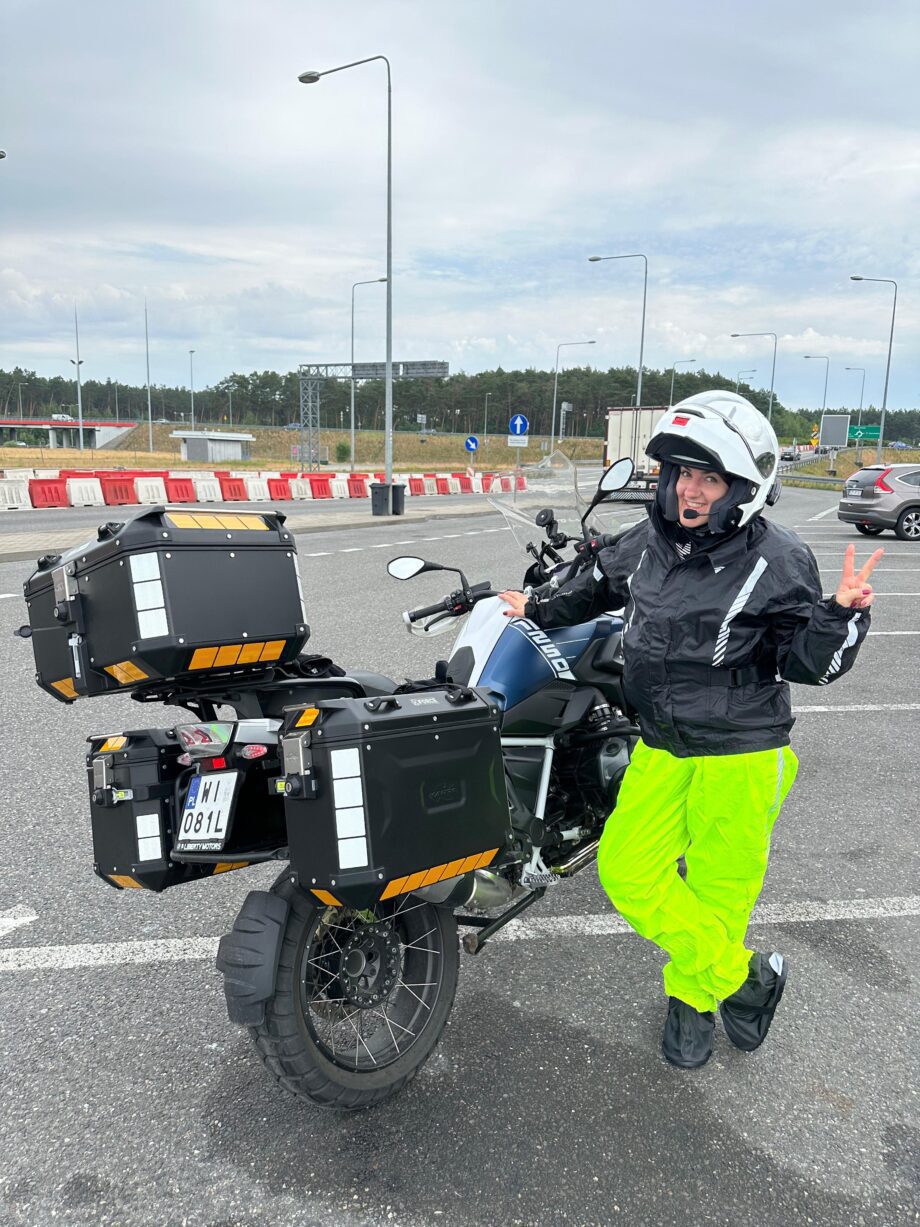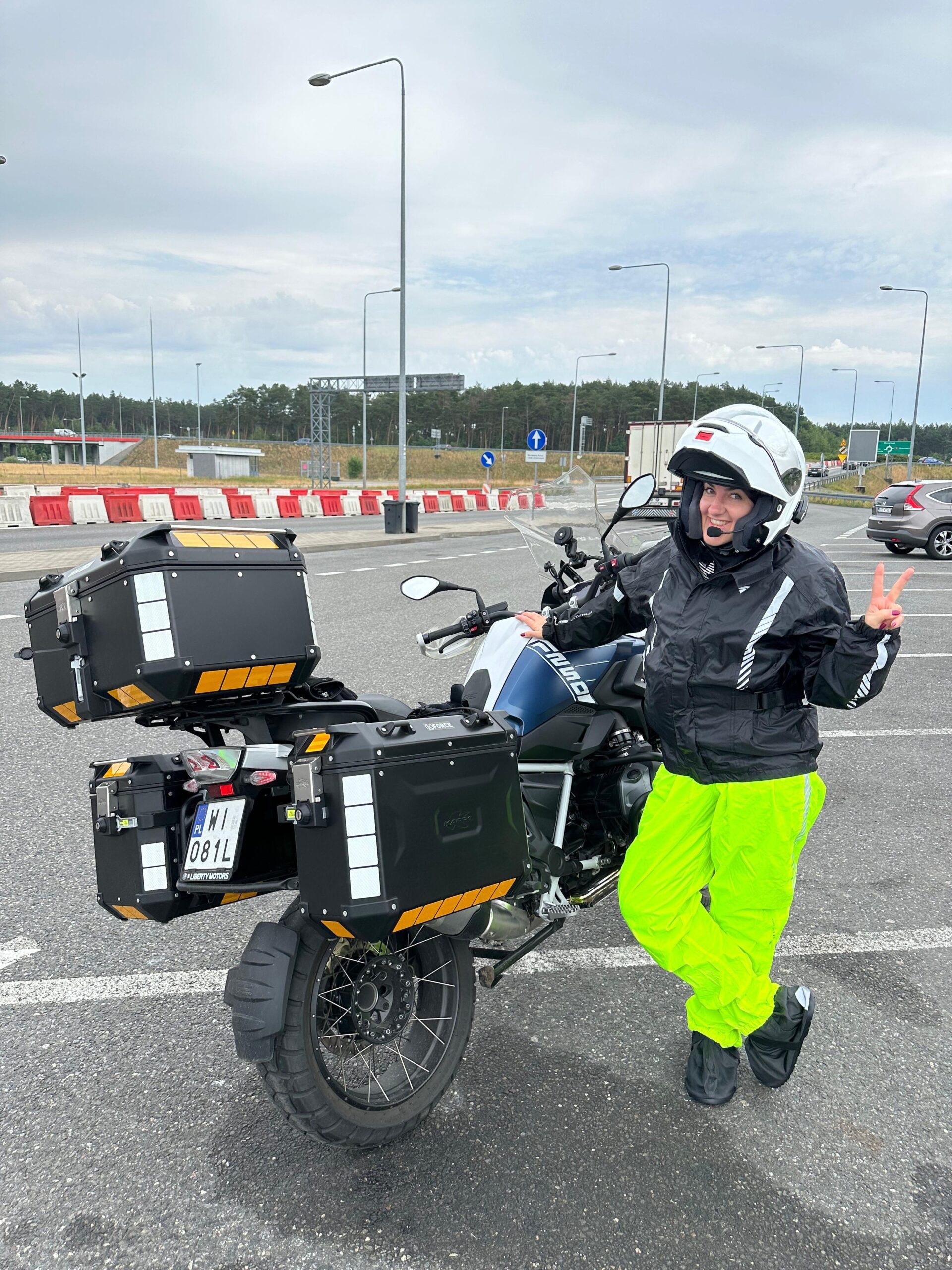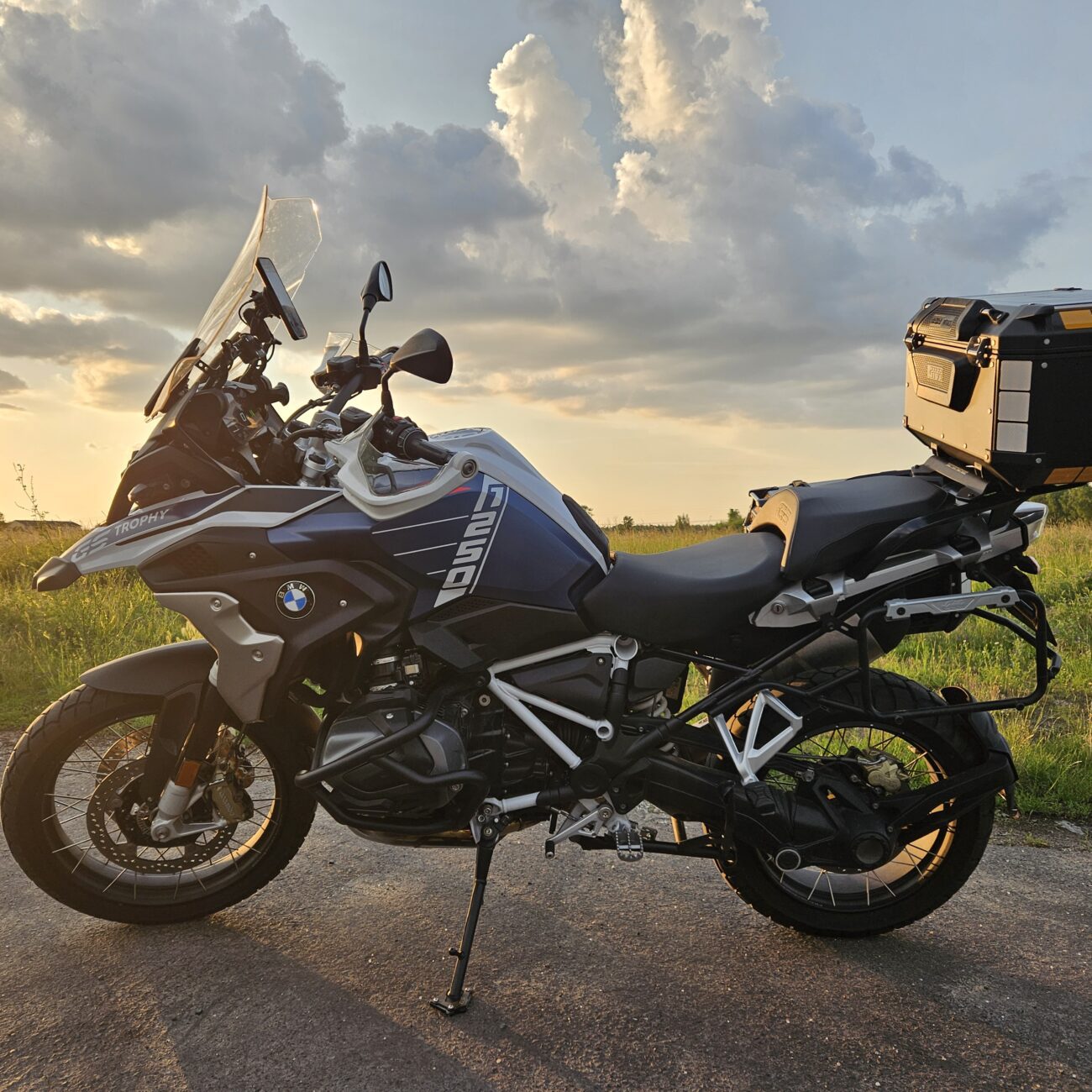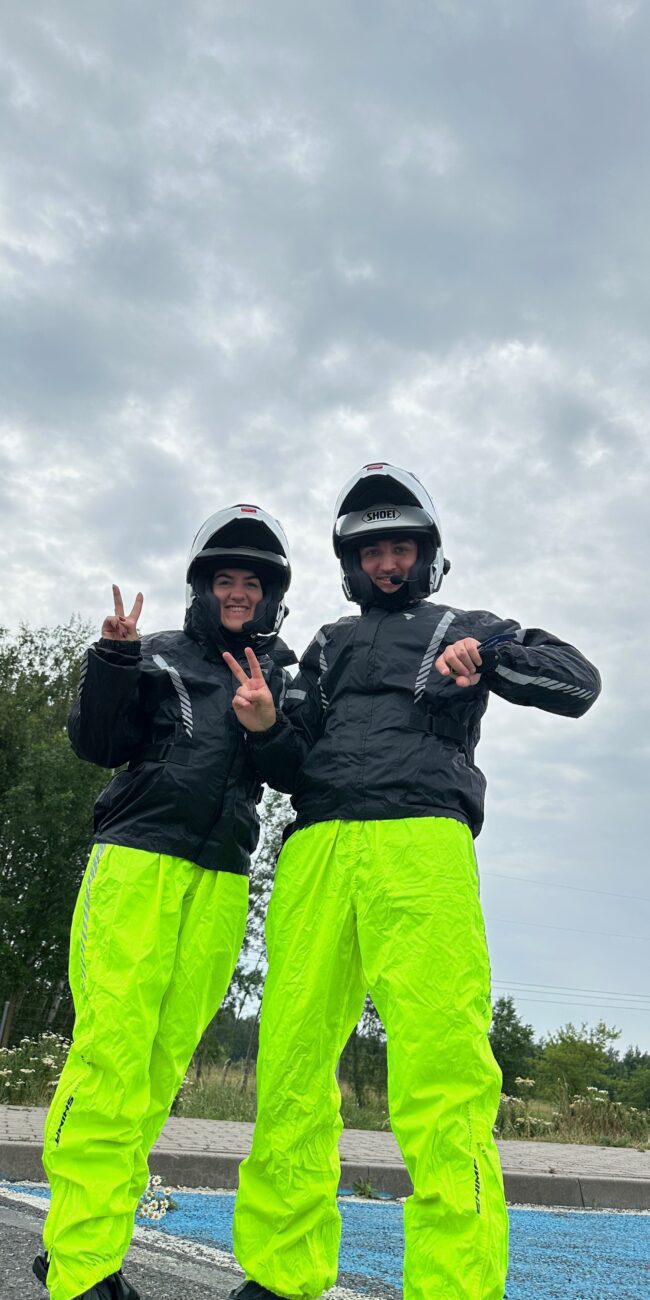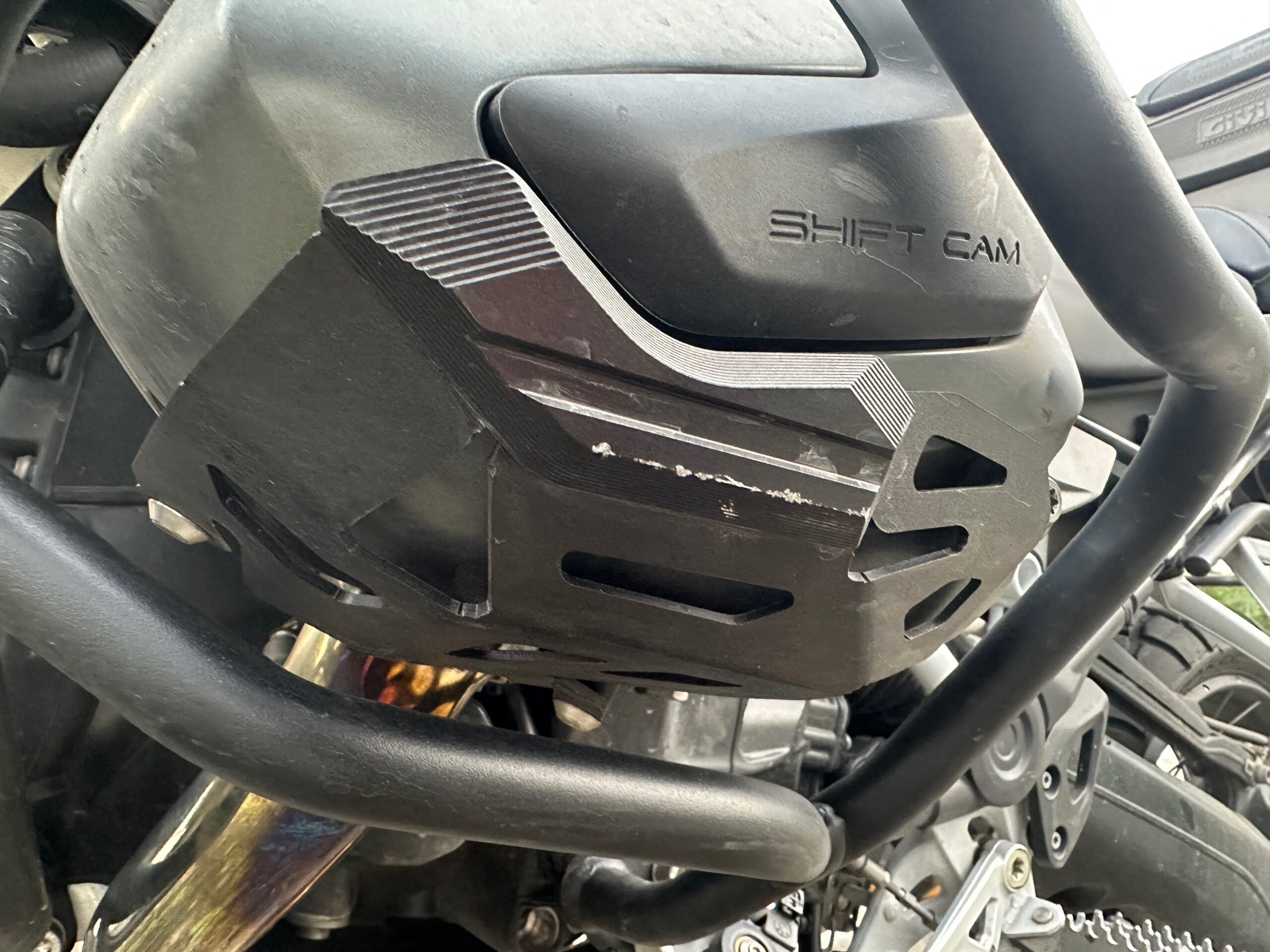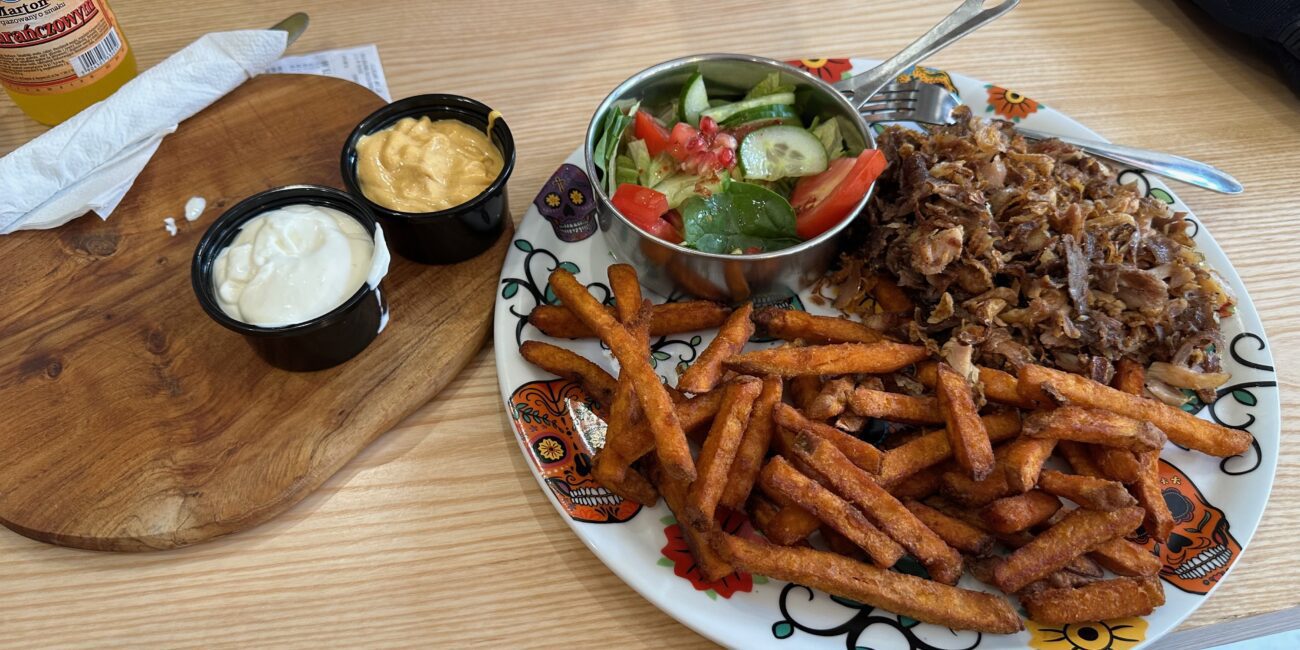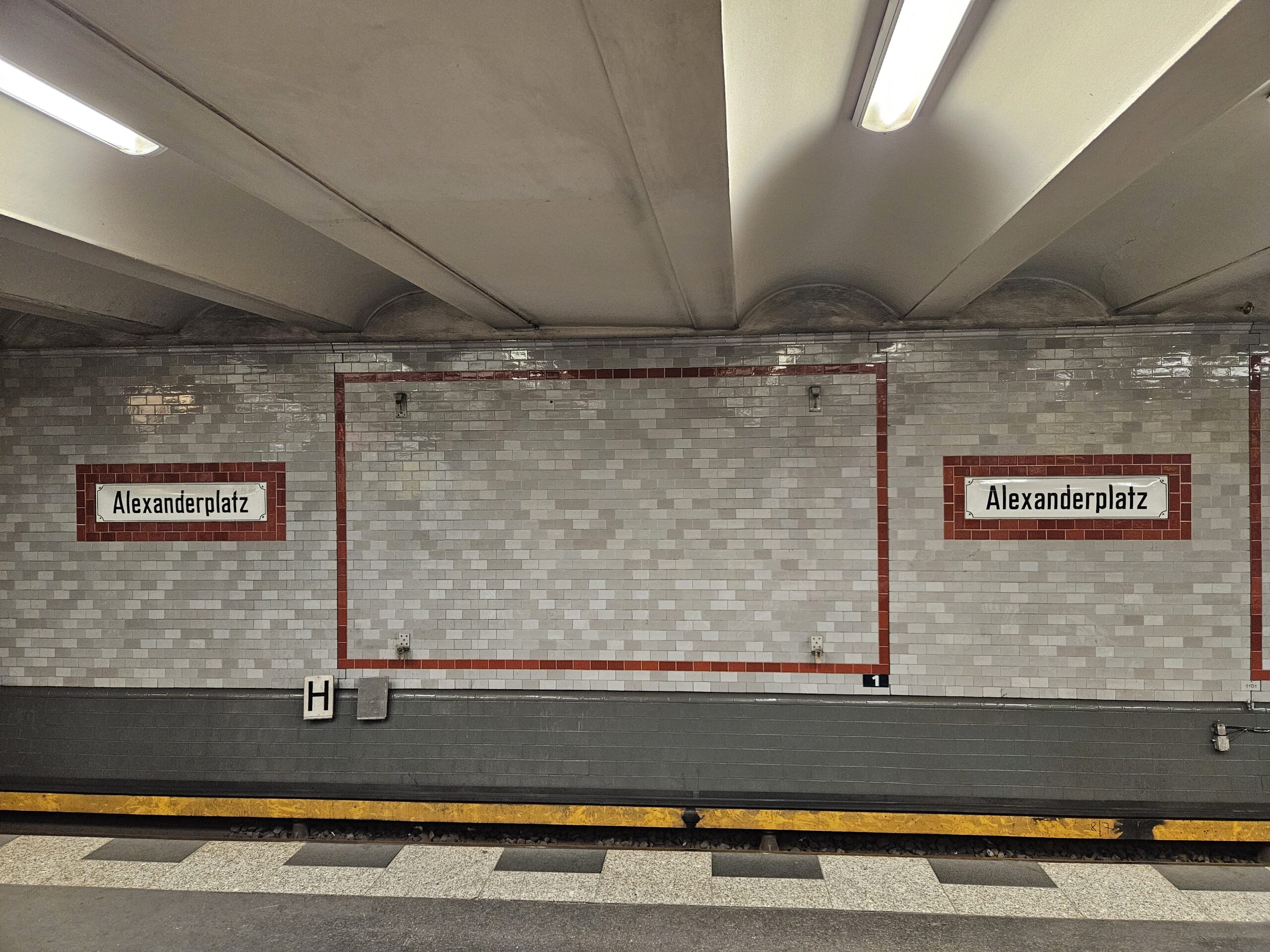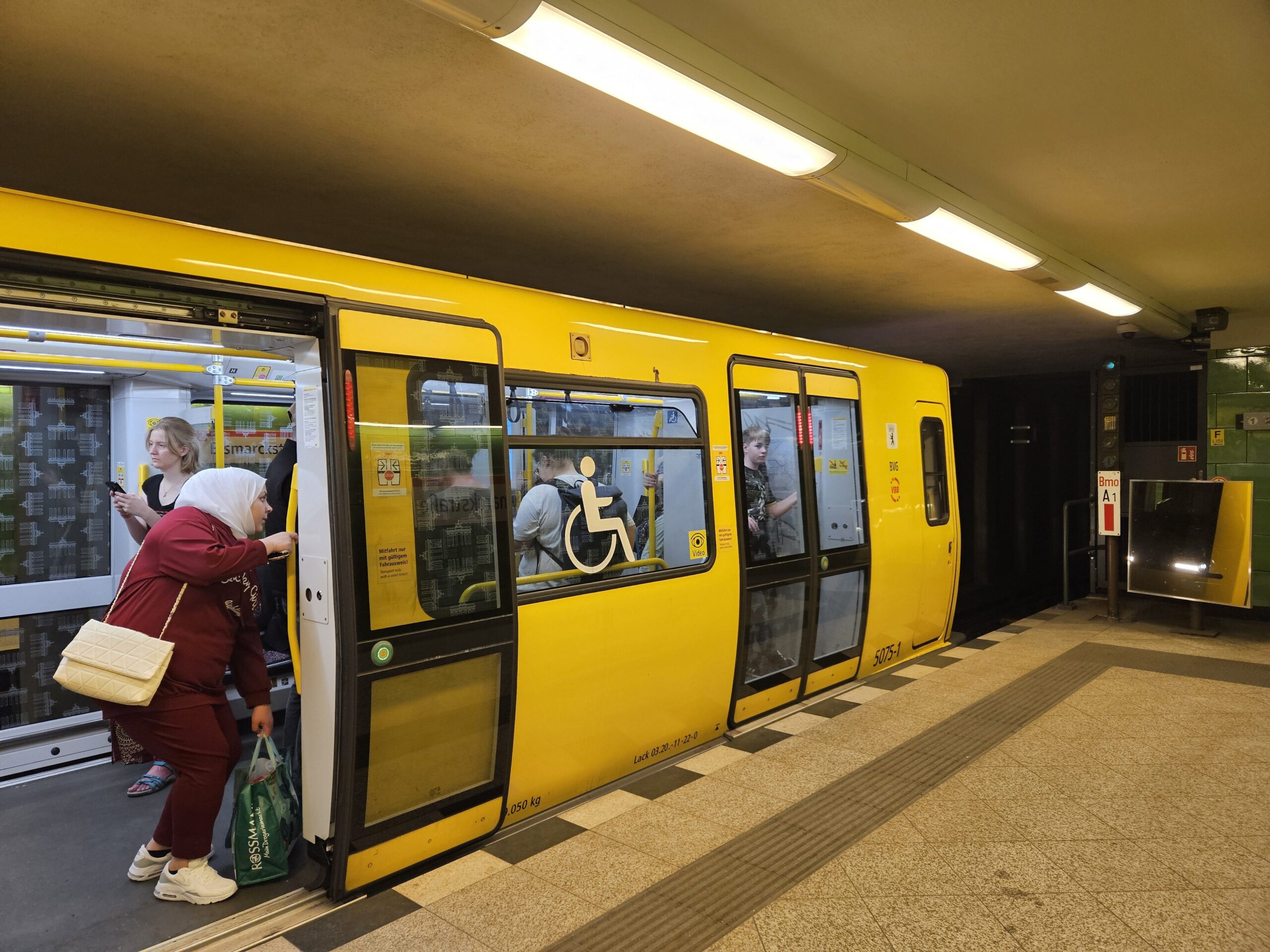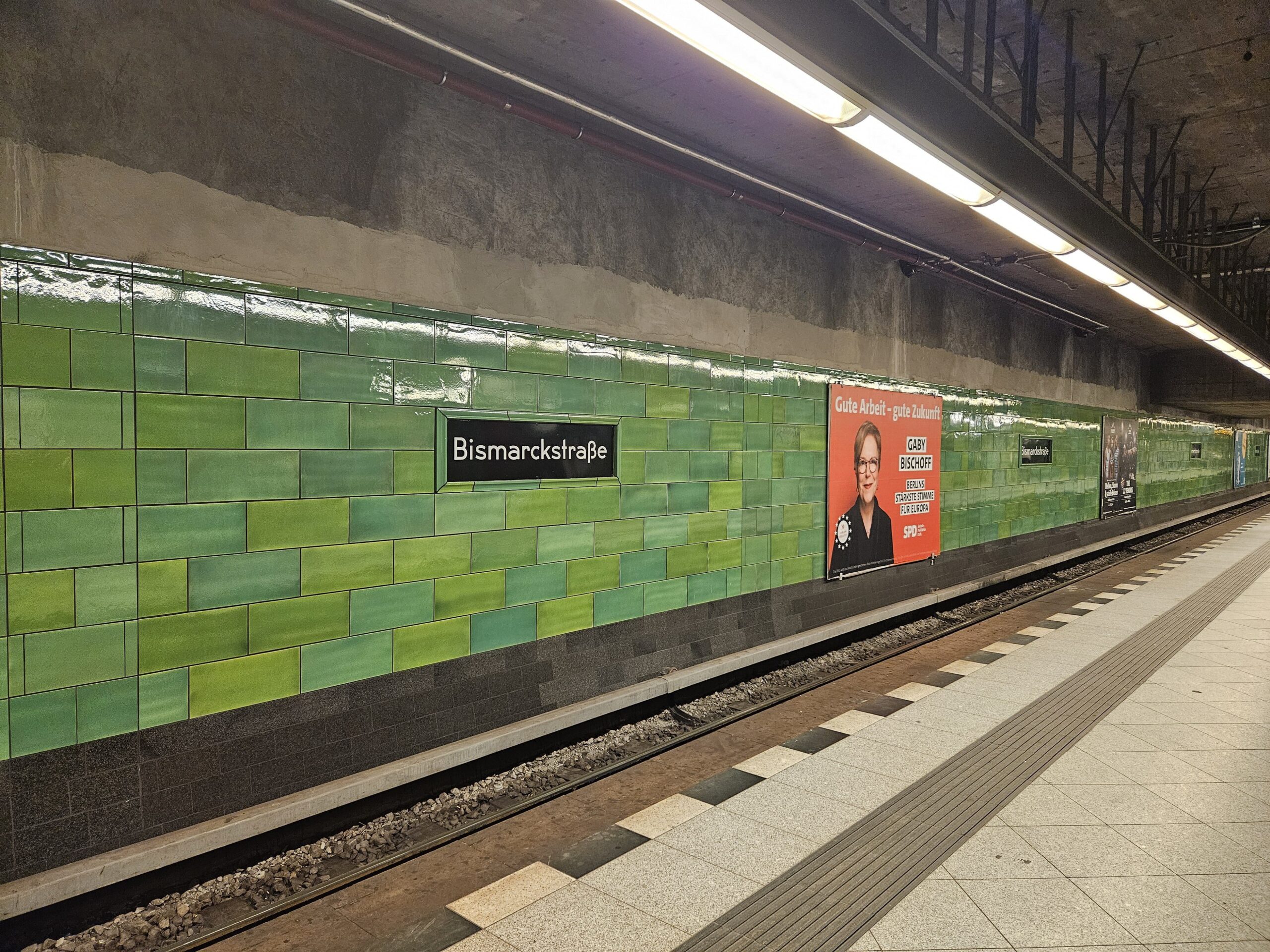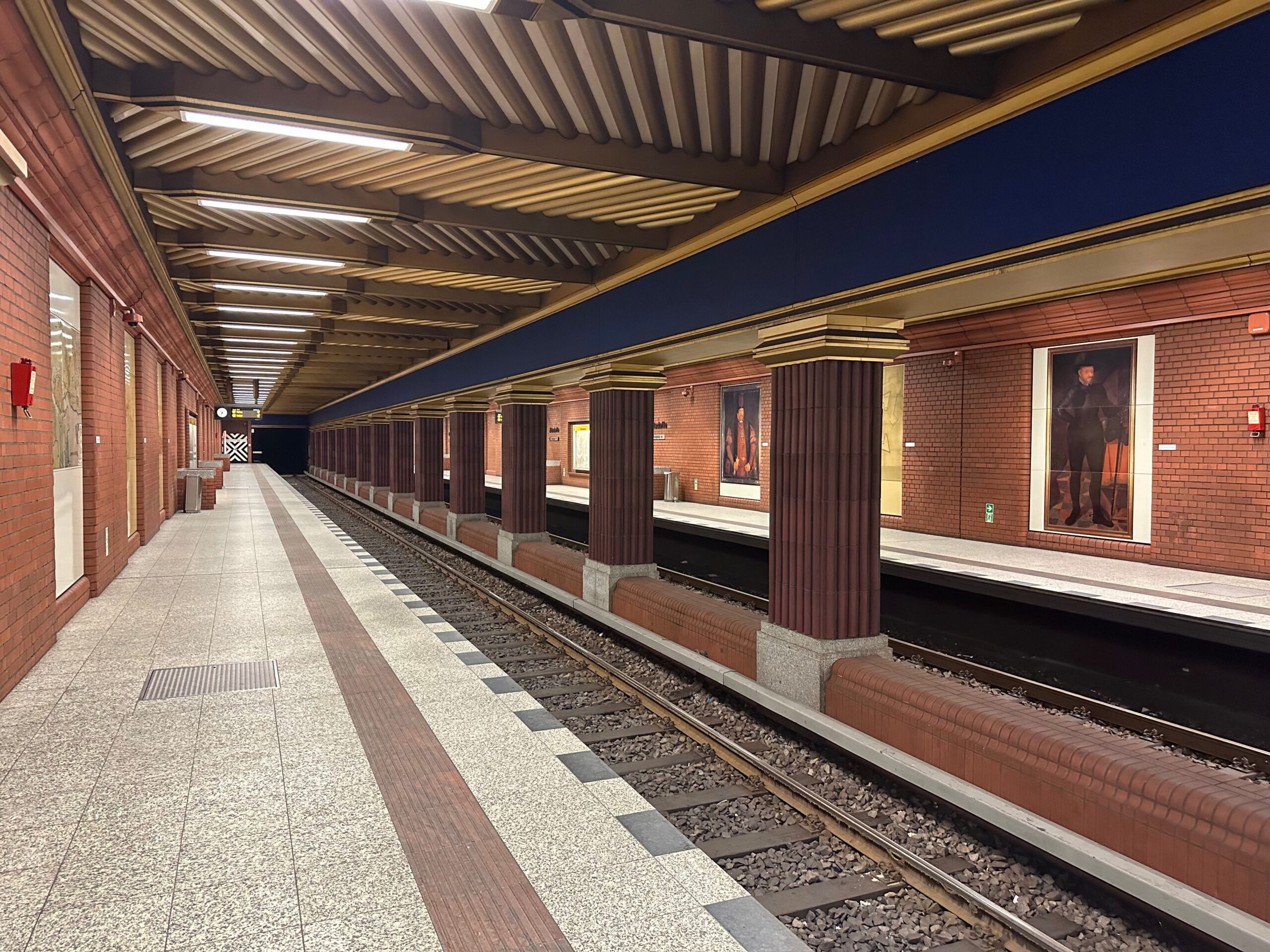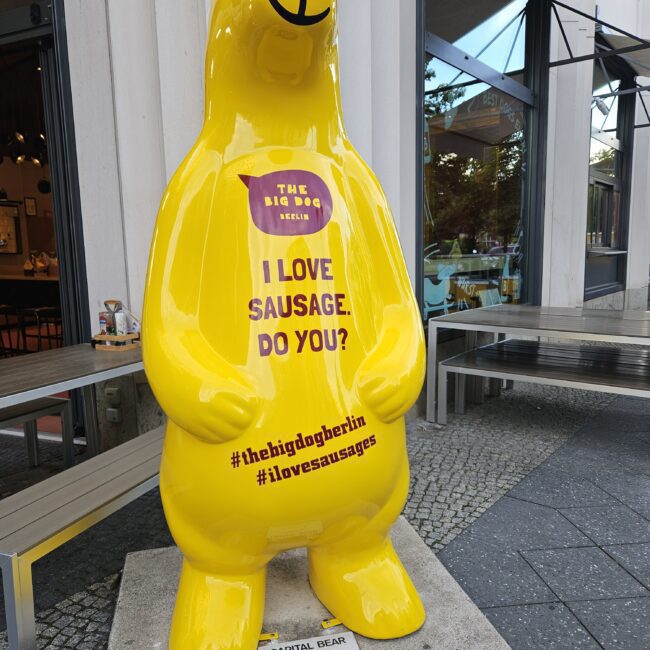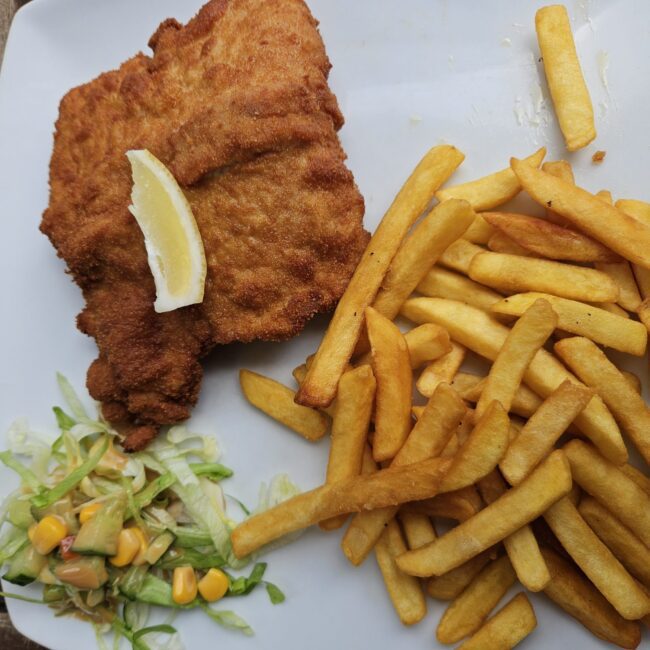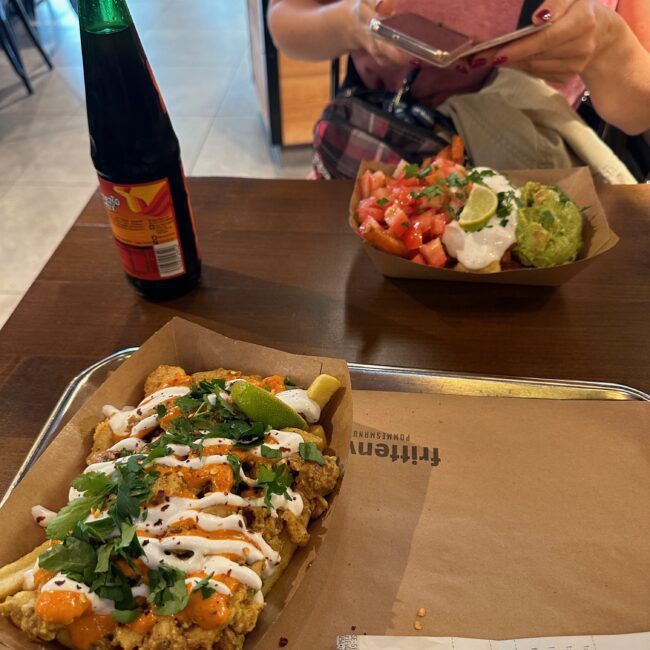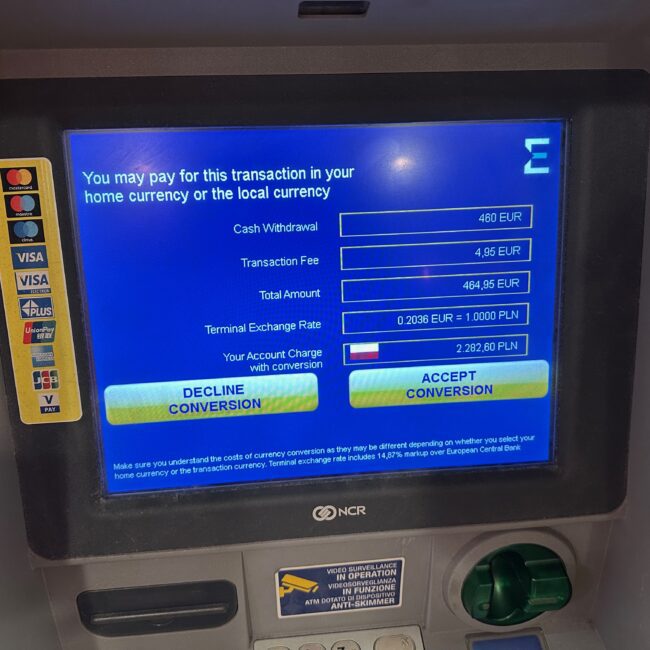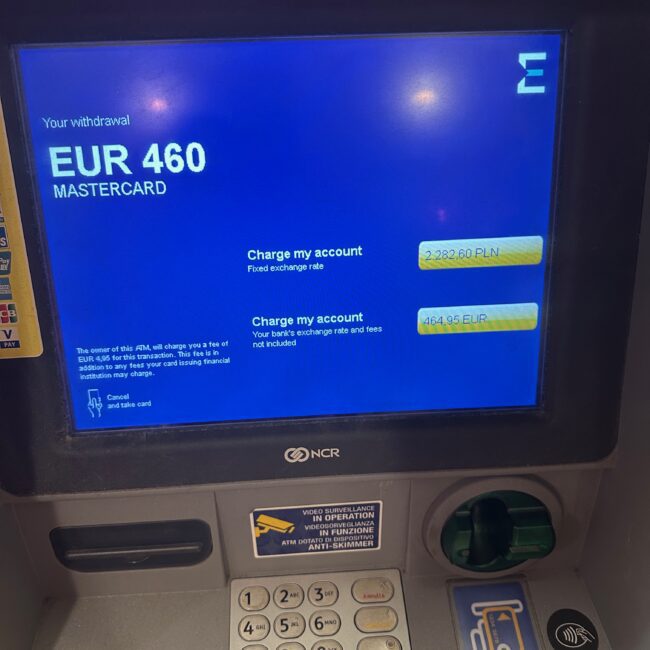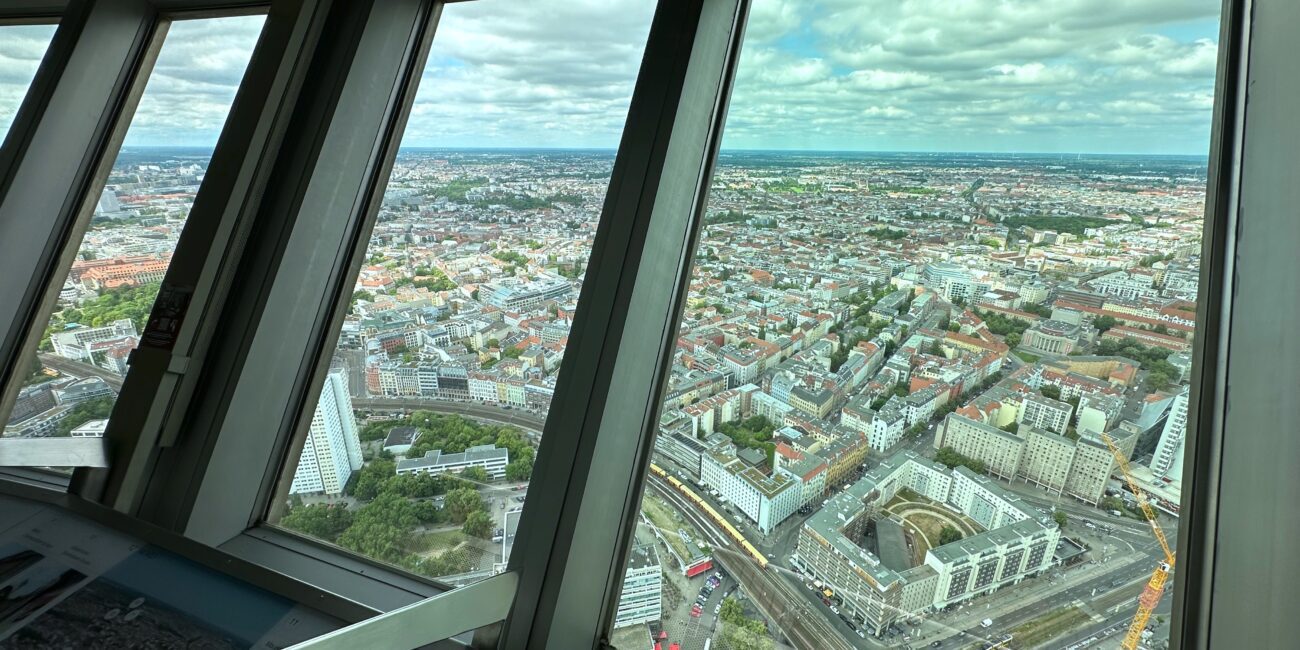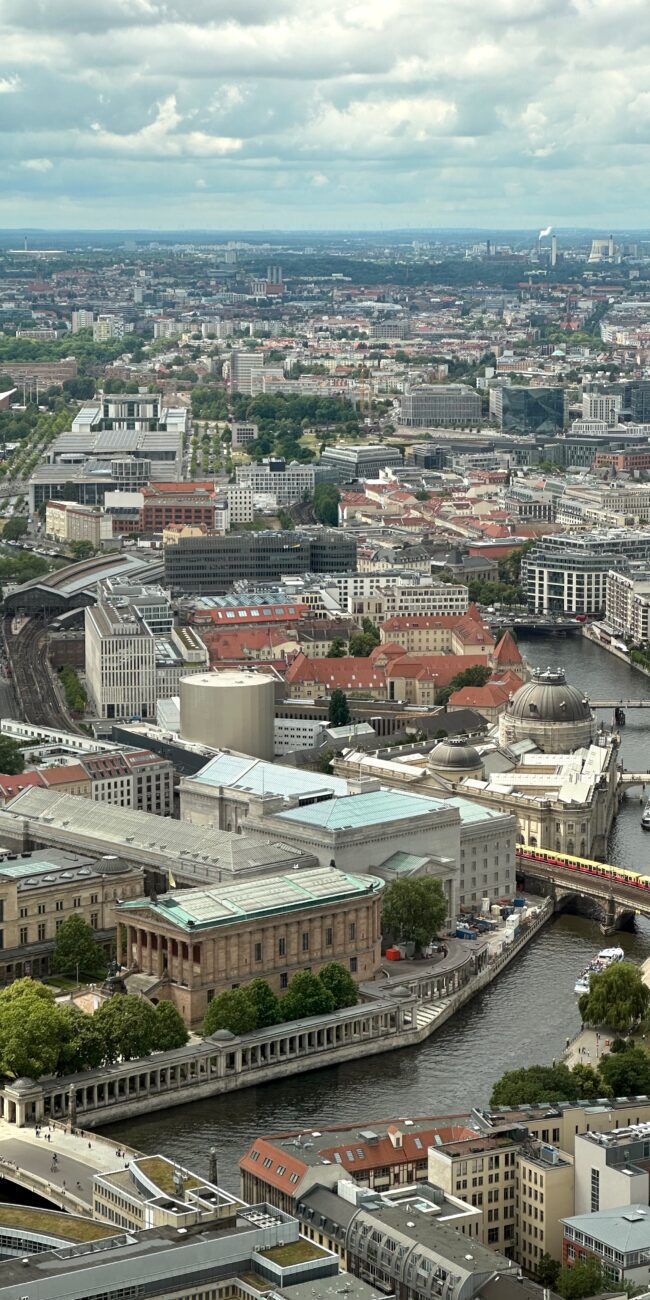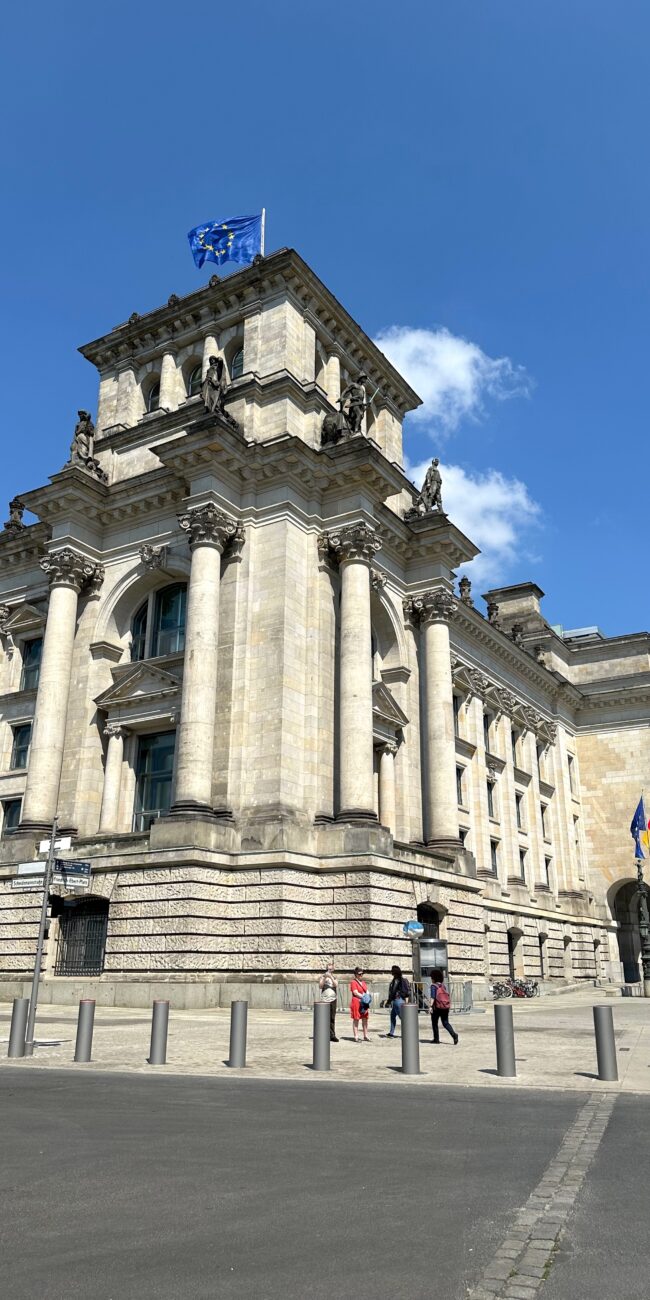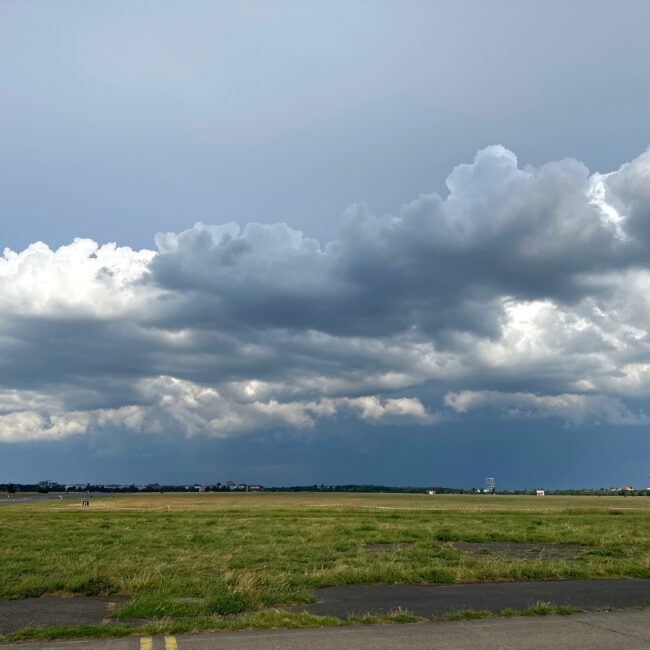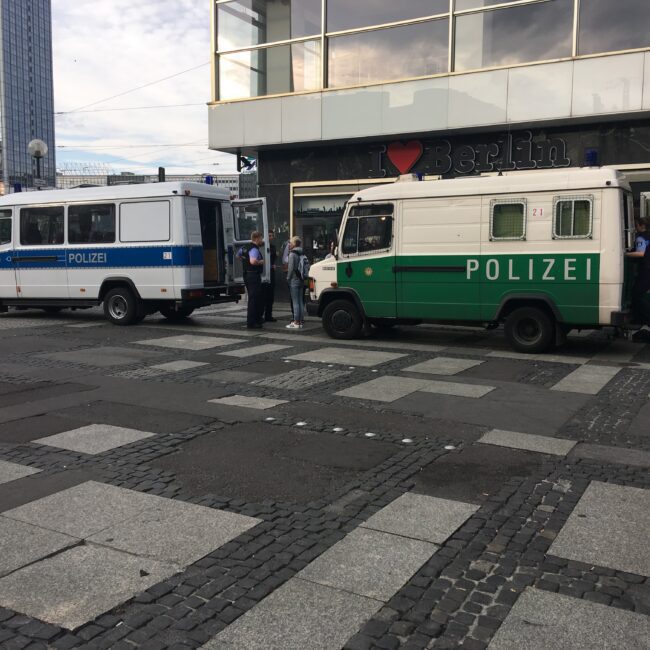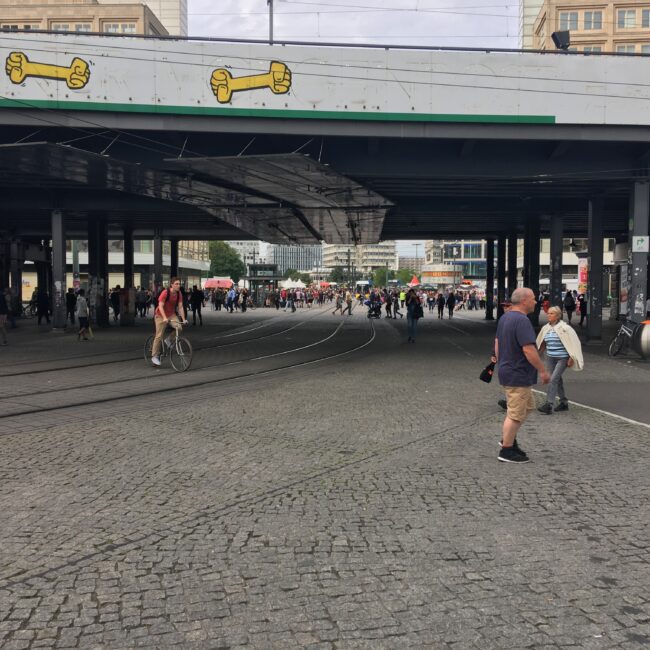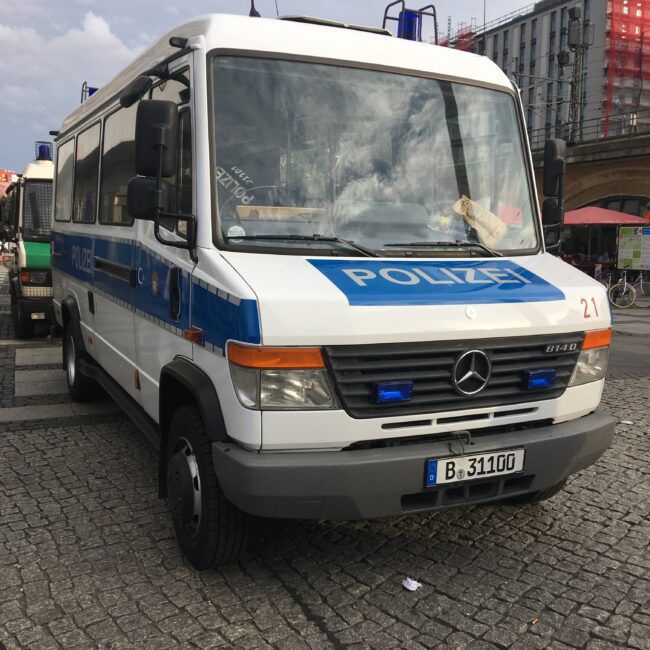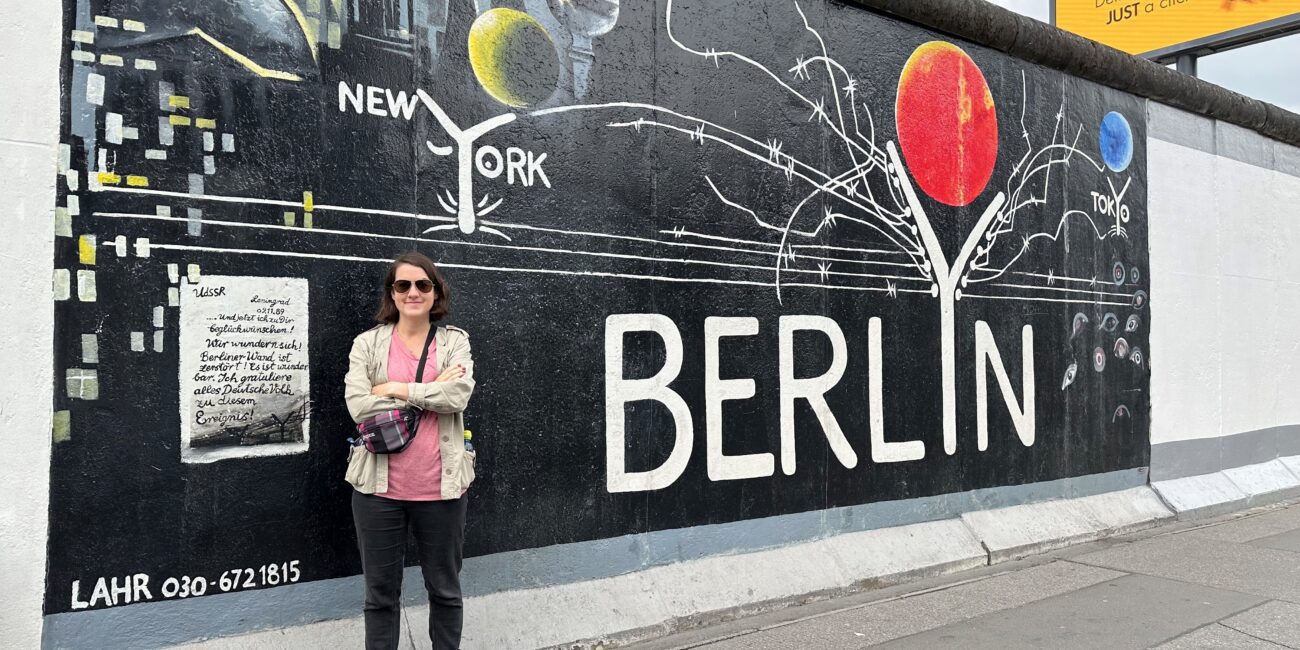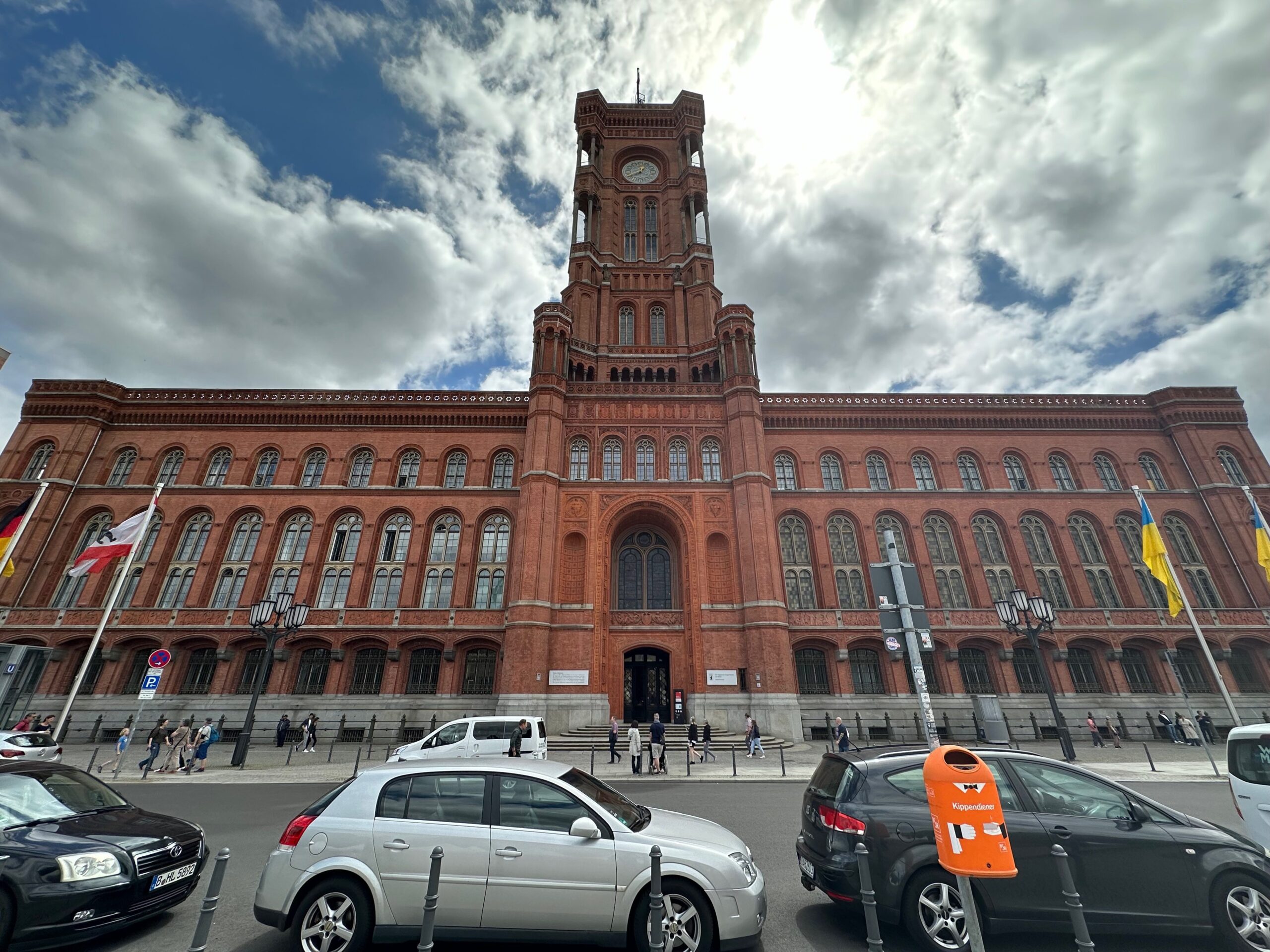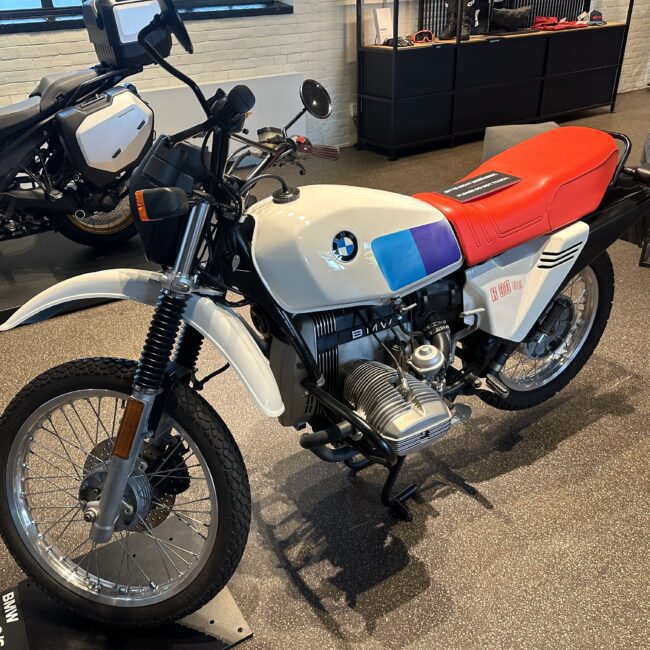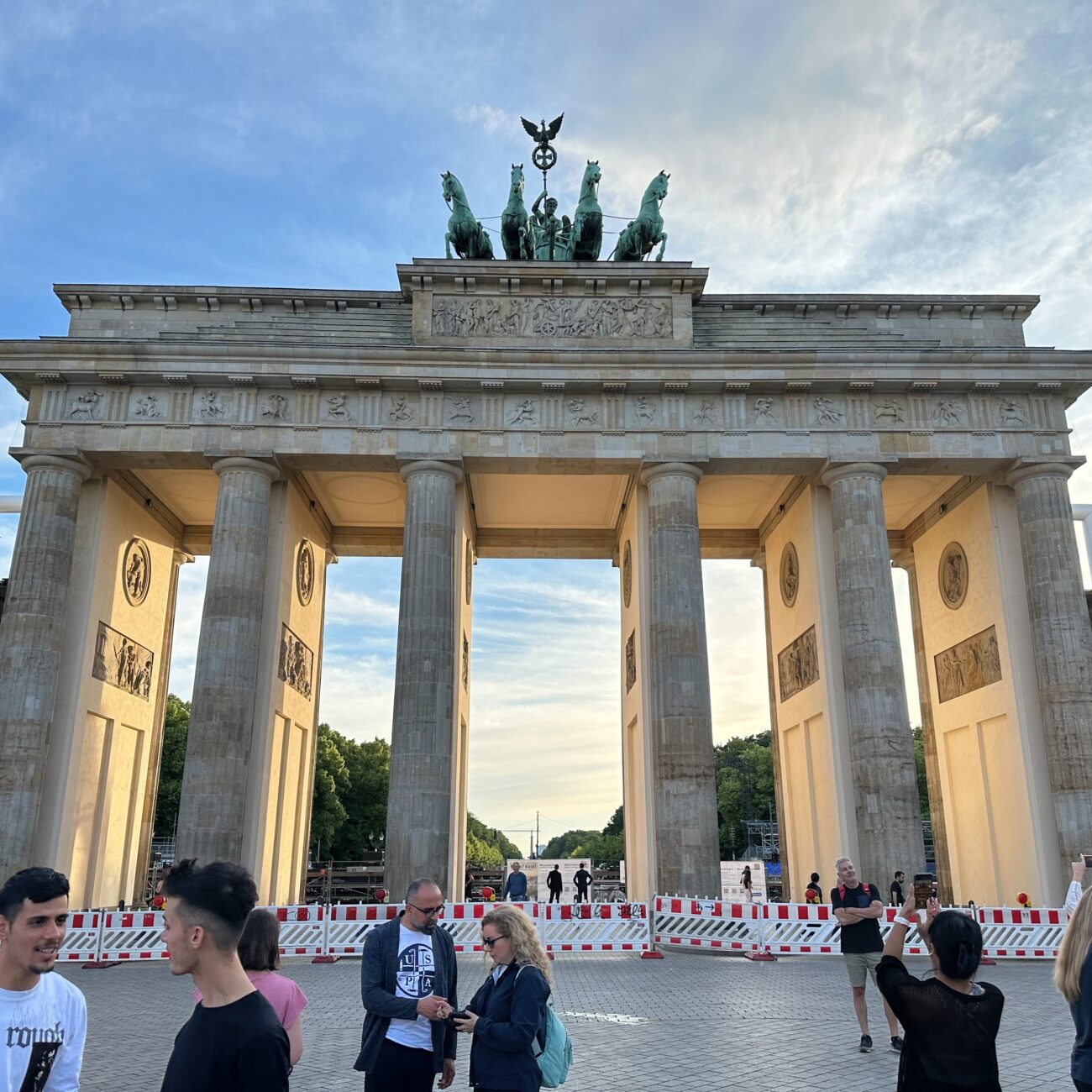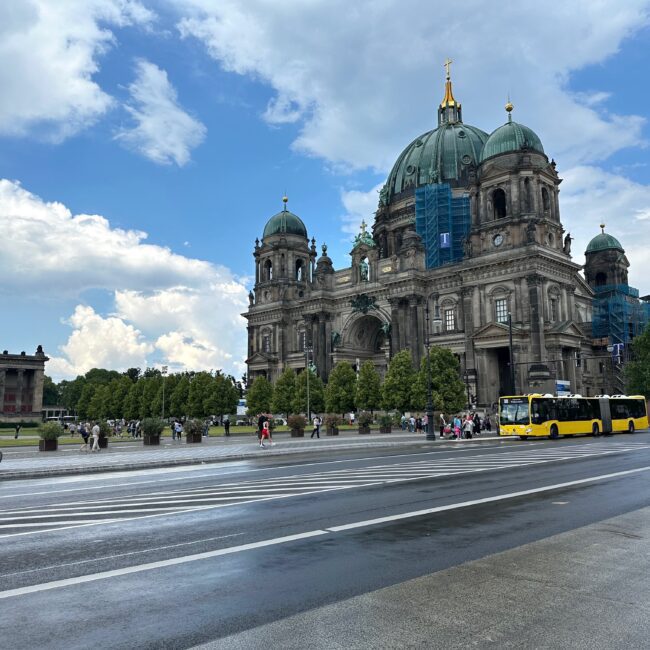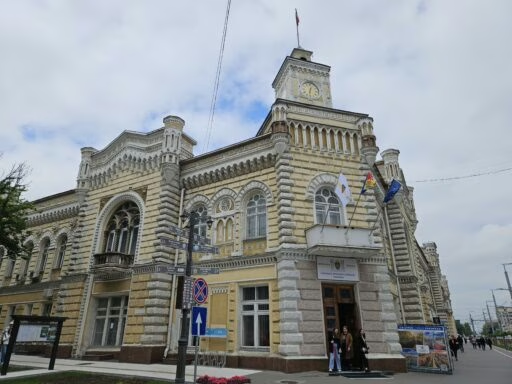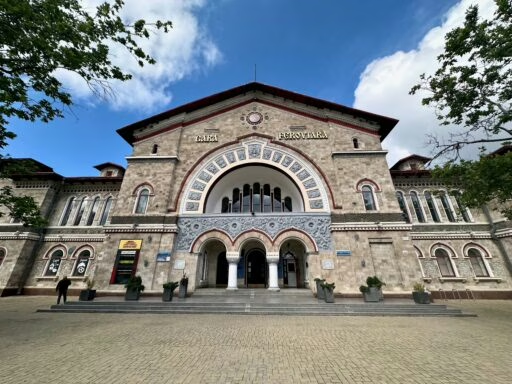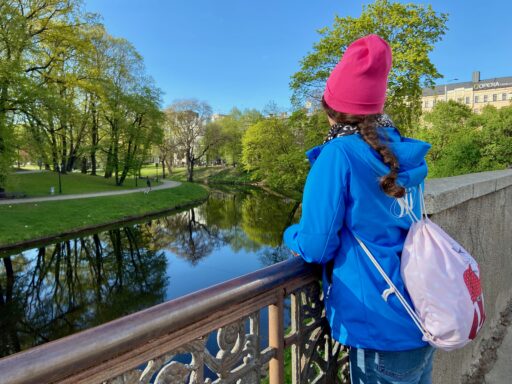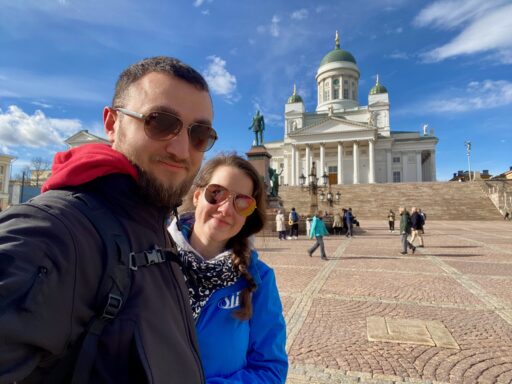This post is also available in:
Polski
Hello! 👋
Our June motorcycle trip to Berlin wasn’t just about relaxation; we also fit in some work commitments. Though we aimed for a weekend break, the trip allowed us to balance business with leisure. Instead of over-planning, we chose a simple route with key stops, making it easy to manage both work and downtime.
In this post, we’ll share details about the route, the sights, and tips for a similar journey. Straightforward and efficient, just how we prefer it.
How did we get to Berlin?
We started on our trip to Berlin with the BMW R1250GS, a bike we leased in February that sports a striking Trophy paint job. With 136 hp and 143 Nm of peak torque, the BMW delivers impressive acceleration and a smooth, comfortable ride. In comparison, our previous Yamaha Tracer fell short in terms of comfort, especially considering our plans for longer journeys. After taking the new bike on its first adventure to Austria in May, we decided to put it to the test again in June with a trip to Berlin.
Driving along the highway from Warsaw, we had rather uncertain weather – sometimes sunny, sometimes rainy, so we relied on rainproof clothing, which, frankly, was not very breathable. Our GS could go about 320 km on a single tank of fuel, so we stopped at every such distance. For our first decent stop we chose Września, where we had a delicious kebab at “Szamka”. This was also the moment when we decided to get off the highway – not only because of the cosmic prices of the A2, but also out of boredom. Riding a motorcycle on the highway is no fun, especially for Jadzia, who was sitting in the back. To keep things from getting too monotonous, we used the Cardo Edge intercom, so we listened to music and chatted while we drove.
Crossing the border
As we approached the German border, we jumped back on the highway. Unfortunately, the border controls were back there, but we were lucky because the officers didn’t pay much attention to us and we kept going. The whole trip took us about eight hours, with regular stops and intercom conversations.
The return trip was similar – the same stop in Września, although this time we were caught in a heavier downpour.For a while we thought the adventure was over when the police stopped us for a routine check just before Września. Everything went well until the officer asked us to park on a slightly sloping driveway. And well, due to the weight of the motorcycle, luggage and ourselves, I lost my balance and we both landed on the ground. Luckily, we were not suspected of being drunk or unlicensed XD and the policewoman was in a good mood, as we continued with a slight smile on our faces. Only a small scratch on the bonnet remained.
Documents
Traveling to Berlin by motorcycle, we did not need to bring passports because we were traveling within the European Union, where an ID card is sufficient. The only thing that required special attention was the documentation related to the vehicle.Since the motorcycle is leased, I had to bring an authorization from the leasing company confirming that I have the right to use the vehicle.This document was translated into several languages, including German. In addition, of course, were the registration certificate, driver’s license and proof of validity of liability and comprehensive coverage.
It is also worth remembering that German traffic regulations are quite strict, especially when it comes to the technical inspection of vehicles. Fortunately, since the bike is new, we didn’t have to worry too much – everything was in perfect condition. However, it is important to always make sure that the documents and insurance are up to date.
Road conditions and public transport
Moving by motorcycle
Getting around Germany by motorcycle, especially getting to Berlin, is very easy and pleasant. German roads are well-maintained – although there are sometimes major highway repairs. In addition, unlike cars, motorcyclists don’t have to worry about the Umweltzone sticker. This is a low-emission zone introduced in many German cities, in which only vehicles that meet certain emission standards are allowed to drive. Motorcycles, however, are exempt from this requirement, making it easier to drive around downtown Berlin and other major cities.
Parking a motorcycle in Berlin is another benefit – you can park on sidewalks, as long as you don’t impede pedestrian traffic and use common sense. This way you can avoid parking fees, which can be quite high in downtown Berlin. It is also worth remembering a few rules, such as parking only in places where it is not expressly forbidden, and leaving adequate space for pedestrians.
As for getting around the city by motorcycle, Berlin has many bus and bicycle lanes that are closed to motorcycles, so you have to watch out for signage. Still, riding a motorcycle around the city is much faster than driving a car, especially during rush hour.
Bus communication
Bus transportation in Berlin is very well developed and is an important part of the public transportation system. The bus network covers all of Berlin and its environs, and buses run frequently, especially in the inner city.
An important convenience is the night bus lines, which run all night, allowing you to move freely around the city after dark. Bus tickets are integrated into Berlin’s entire public transportation system, so the same ticket can be used on the subway, S-Bahn and trams. Tickets can be purchased from vending machines, mobile apps and directly from drivers, although only single tickets are available from drivers.
If you are traveling around Berlin by motorcycle, consider using buses in case of bad weather or if you want to explore the city without worrying about parking.
👉 For more information, visit the official BVG website – click here.
Subway
The Berlin subway is one of the most convenient and fastest ways to get around the city. With nine lines and more than 170 stations, you can get almost anywhere.
In our experience, the Berlin subway was on time and very convenient. Trains were regularly on time and ran every few minutes during rush hour. However, as is the case with public transportation, something unforeseen can always happen that causes delays or breakdowns. This is something to keep in mind, but overall the subway gives a sense of reliability, especially compared to other major cities.
It is also worth noting that the U-Bahn is part of Berlin’s integrated ticketing system, which means that you can use the U-Bahn, buses, trams and S-Bahn with one ticket. Tickets can be purchased from ticket machines at stations, through mobile apps or at kiosks. The subway also covers fare zones AB and, for those traveling to the outskirts of Berlin, zone C.
👉 A map of all transport connections can be found on the official BVG website – click here.
Suburban railway
Berlin’s suburban rail system, the S-Bahn, is an excellent complement to the subway, especially when traveling longer distances or to outlying areas. The S-Bahn network covers the central areas of Berlin as well as other parts of the city and surrounding areas. S-Bahn trains run at ground level, which makes riding them an opportunity to admire the city.
👉 You can find the exact costs associated with public transport tickets on the official BVG website – click here.
Accommodation
While in Berlin, we stayed at the Campanile Berlin Brandenburg Airport Hotel. This hotel offered great value for money, especially compared to more expensive accommodations in downtown Berlin. Another advantage was the free parking, which allowed us to park our motorcycle right under the window. This allowed us to keep an eye on it at all times, which gave us peace of mind.
👉 Direct link to the hotel – click here.
The room was basic but clean and comfortable. Breakfast was included, which was very convenient, especially for early risers.
The hotel is about a 15-minute walk from the S-Bahn station, making it easy to reach Berlin Brandenburg Airport (BER). It’s a great option if you need a safe place to leave your car while flying. Parking at the hotel is free or significantly cheaper than at the airport, saving you money. Many drivers use this option, leaving their cars and taking the S-Bahn to the airport without any hassle.
For us, the location of the Campanile Berlin Brandenburg Airport Hotel worked well. We had a motorcycle or could easily take a quick train ride into the city. The trip to central Berlin didn’t take long, and given the price, it was a great deal.
SIM card
While in Berlin, we did not need to use a local SIM card. Our Polish numbers worked without additional roaming charges, in accordance with EU regulations. This is a great advantage when traveling in Europe because you can use the Internet, make calls and send messages without worrying about additional costs.
However, it’s worth checking your contract with your operator, because although roaming is free under EU regulations, it doesn’t mean you have unlimited data access. There is usually a limit to how much data you can use while roaming, depending on your plan. It’s a good idea to check how much data you have available so you’re not surprised by additional charges if you exceed your limit. If the data limit turns out to be too low, you can consider buying a local SIM card.
Food
We had little trouble finding food. The day we arrived in Berlin, we went out for pizza, and the following days we ate out – fries, schnitzel, simple food, without focusing on traditional German dishes. The priority was just to eat and continue to run.
We also visited McDonald’s, but unfortunately it was not the best experience. Several homeless people who were staying at the restaurant were practically disgusted by the fast food and were not in favor of a peaceful meal, which somewhat ruined the experience of the place.
Exchange office or ATM?
For a long time, we have been using currency cards for cash withdrawals from ATMs, which is convenient and cost-effective as there is no need to search for exchange offices. In Germany, however, ATMs may charge fees for withdrawals, the amount of which depends on the ATM operator. ATMs operated by major banks, such as Deutsche Bank, Commerzbank, HypoVereinsbank and Postbank, usually offer lower or no fees, especially if you use banks that are part of the Global ATM Alliance network, which allows free withdrawals for customers of partner banks.
In contrast, private ATMs such as Euronet or Travelex may charge fees ranging from €1.95 to €7.50 per transaction. The ATM will always inform you of the fee before completing the transaction, so you can make an informed decision. It is also important to always choose to withdraw in the local currency (EUR) to avoid the unfavorable currency conversion offered by ATMs.
Climate and weather conditions
Berlin has a temperate climate, meaning the weather is generally mild but can be quite variable. Summer temperatures range from 20 to 30°C, though rainy days are common, especially in June and July. Humidity can be high, and the weather changes quickly, as we experienced during our trip — from sunshine to rain.
In winter, temperatures drop to around 0°C, with occasional snowfall, though it’s usually light. Spring and fall bring more unpredictable weather, with frequent rain and wind. If you’re on a motorcycle, rain gear is essential during these seasons.
While Berlin doesn’t face extreme weather events like hurricanes, the changeable conditions during our June 2024 visit required flexibility in both planning and clothing choices.
Safety
Berlin is generally considered a safe city, and we did not experience any unpleasant incidents during our stay. However, as in any large city, it is advisable to remain vigilant, especially in crowded areas such as subway stations, bus stops, and popular tourist attractions. The most common danger you may encounter is petty theft, especially in crowds or on public transportation. It is advisable to keep an eye on your belongings, especially at night, and avoid showing large sums of cash or expensive items.
Immigrants are highly visible in Berlin, giving the city a distinctive multicultural character. They can be found in various neighborhoods, such as Kreuzberg and Neukölln, where many people from Turkey, the Middle East and Africa live. Their presence influences the daily life of the city, from the variety of restaurants and shops to multicultural events. Berlin has long attracted immigrants, which is reflected not only in the urban fabric, but also in the culture and lifestyle of its residents.
Places we visited
During our motorcycle trip to Berlin, we explored some fantastic spots that are definitely worth visiting. If you want to know more about these attractions, check out our separate article here. We dive into the details of our adventures, packed with photos and fun facts. Don’t miss it! 😊 🏍️ 🌍
Summary
All in all, our motorcycle trip to Berlin was a quick and successful trip. We got around the city and its surroundings without any major problems. Thanks to favorable conditions for motorcyclists, such as no need for an environmental zone and the ability to park on sidewalks, we were able to explore Berlin flexibly. The weather was changeable but did not hinder our trip. The food was simple, without any particular complications.

